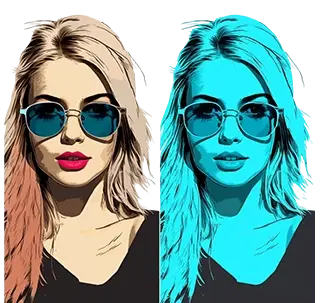Why You Need a Vector Conversion Service: A Complete Guide to Raster to Vector Conversion

Why You Need a Vector Conversion Service: A Complete Guide to Raster to Vector Conversion
If you've ever tried to scale up a blurry logo or get a clean print of a low-quality image, you already know the struggle of working with pixel-based files. That’s where a vector conversion service becomes not just useful—but essential.
In this blog, we’ll break down what raster to vector conversion is, why it matters, and how a reliable service can save you time, money, and a ton of frustration.
What Is Raster to Vector Conversion?
Let’s start with the basics.
Raster images (also called bitmap images) are made of tiny squares called pixels. Common file types include JPG, PNG, and GIF. These images are great for web use but don’t scale well. If you zoom in or enlarge them, they quickly become blurry or pixelated.
Vector images, on the other hand, are made using mathematical paths and curves. They can be scaled infinitely without losing quality. Common vector file formats include SVG, AI, PDF, and EPS.
Raster to vector conversion is the process of transforming a pixel-based image into a clean, scalable vector file—something that looks sharp whether it's printed on a business card or a billboard.
Why Vector Conversion Matters
Here’s where the need for a professional vector conversion service comes in. If you’re working in design, embroidery, screen printing, signage, or promotional products, chances are you’ll need a vector version of your artwork at some point.
Here’s why vector files are so valuable:
-
Scalability: Resize without losing quality
-
Editability: Make changes to shapes, colors, and lines easily
-
Print-Ready: Required by most printers and manufacturers
-
Cleaner Output: No pixelation or blur, even at large sizes
Whether it’s a company logo, event artwork, or custom design, having a clean vector file makes your work look more professional and polished.
When Do You Need a Vector Conversion Service?
Not everyone has access to software like Adobe Illustrator—or the time and skill to manually trace complex images. That’s where a professional vector conversion service comes in handy.
You might need this service if:
-
You only have a low-resolution version of a logo (like a JPG or PNG)
-
Your design has fuzzy edges or doesn’t print cleanly
-
You’re creating embroidery files, screen prints, or engraved materials
-
You need to submit artwork for banners, signs, or promotional products
Instead of spending hours trying to trace it yourself or relying on auto-tracing tools that give poor results, a vector conversion service can recreate your design manually with precision and care.
Manual vs. Auto Vector Conversion
It’s important to understand that not all vector conversions are created equal.
Some services use auto-tracing software to convert images in seconds. While fast, these tools often produce rough edges, inaccurate shapes, and extra points that make the file hard to edit or unusable for production.
Manual raster to vector conversion involves carefully redrawing each part of the image using vector tools. This results in a cleaner, smoother, and more accurate final file that’s production-ready.
When quality matters, manual vector conversion is the way to go.
What to Expect from a Good Vector Conversion Service
Choosing the right vector conversion service makes a big difference. Here’s what you should look for:
Accuracy
The final vector should match your original design as closely as possible—without distortions, missing elements, or strange colors.
Fast Turnaround
Most professional services can deliver within 24–48 hours, sometimes even faster for urgent jobs.
Multiple File Formats
You should receive your final artwork in multiple vector formats (AI, EPS, SVG, PDF) so it's ready for any type of project.
Responsive Support
If changes are needed or you have questions, a good service will communicate clearly and respond quickly.
Real-World Uses for Vector Conversion
Still wondering how raster to vector conversion plays out in the real world? Here are a few examples:
-
Embroidery: Converting a raster logo into a clean vector helps digitizers create better stitch files
-
Apparel Printing: Screen printers require crisp vector files for clean prints
-
Signage: Large-format printers need scalable artwork for banners, vehicle wraps, and signs
-
Branding: A business without a vector logo will struggle to create polished marketing materials
Final Thoughts
A reliable vector conversion service is more than just a technical solution—it’s a creative bridge between your ideas and a polished, professional result.
Whether you’re an artist, small business owner, designer, or printer, having access to clean, scalable vector files is a must. And if all you have is a blurry JPG or a low-res PNG, raster to vector conversion is the first step toward getting your design production-ready.
Instead of struggling with bad tracing tools or messy auto-conversions, let the experts handle it. The right service will make your artwork shine—no pixelation, no stress, just clean results every time.
- Art
- Causes
- Crafts
- Dance
- Drinks
- Film
- Fitness
- Food
- Games
- Gardening
- Health
- Home
- Literature
- Music
- Networking
- Other
- Party
- Religion
- Shopping
- Sports
- Theater
- Wellness


